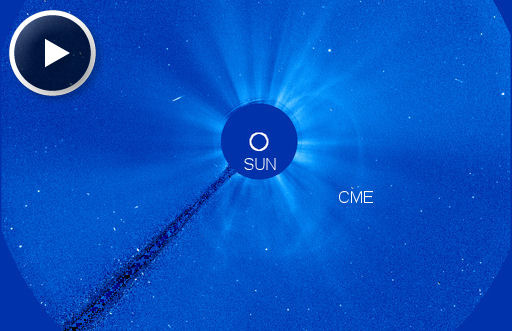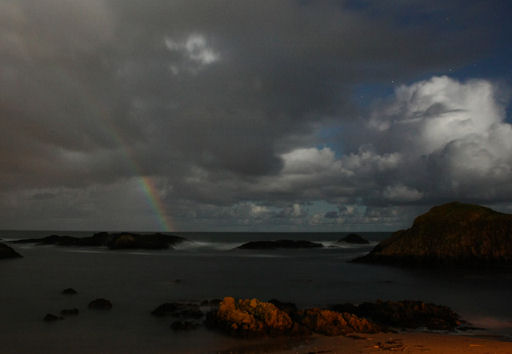Thirty-five new items have just been added to our Meteorite Jewelry collection. Browse the Space Weather Store for something out of this world. | | |
DRACONID METEOR SHOWER: The notoroiusly unpredictable Draconid meteor shower peaks this year on the night of Oct. 7-8. In most years, the Draconids come and go with a barely noticable peak of 10 or so meteors per hour. Occasionally, however, Earth passes through a dense clump of debris from parent comet 21P/Giacobini-Zinner and a meteor storm erupts. Just last year, Europeans witnessed a faint but furious outburst of 600 per hour. There is no reason to believe that 2012 is a "storm year." Nevertheless, northern hemisphere sky watchers are encouraged to be alert for slow-moving Draconids on Sunday night.
EARTH-DIRECTED CME: Magnetic fields near sunspot AR1582 slowly erupted on Oct 5th sparking a B7-class solar flare and hurling a CME toward Earth. The Solar and Heliosphere Observatory (SOHO) captured this image of the expanding cloud:

Although Earth is in the line of fire, it won't be a direct hit. Instead, the CME will deliver a glancing blow to our planet's magnetic field. NOAA forecasters estimate a 20% chance of polar geomagnetic storms when the cloud arrives on Oct. 8th. High-latitude sky watchers should be alert for auroras especially during the hours around local midnight. Aurora alerts: text, voice
Realtime Aurora Photo Gallery
A RAINBOW AT NIGHT: Everyone has seen a rainbow during the day. Bright sunlight bounces off raindrops to produce a colorful arc of red, green and blue. But what about at night? Without sunlight, a rainbow would seem to be impossible. Nevertheless, Martin McKenna saw one on the night of Oct. 3rd over Ballintoy Harbour in Northern Ireland:

This is a type of rainbow called a "moonbow," formed by the light of the Moon instead of the sun.
"I was fortunate enough to catch these rare moonbows over the surreal moonlit Atlantic Ocean at Ballintoy Harbour," says McKenna. "The gibbous moon rising in the east produced enough light to illuminate the off-shore showers, which produced a near complete moonbow. I could see red, yellow, and white colours with the naked eye. The scene looked amazing over the ancient coastline."
Realtime Space Weather Photo Gallery
Realtime Noctilucent Cloud Photo Gallery
[previous years: 2003, 2004, 2005, 2006, 2007, 2008, 2009, 2011]
Potentially Hazardous Asteroids (
PHAs) are space rocks larger than approximately 100m that can come closer to Earth than 0.05 AU. None of the known PHAs is on a collision course with our planet, although astronomers are finding
new ones all the time.
On October 6, 2012 there were potentially hazardous asteroids.
Notes: LD means "Lunar Distance." 1 LD = 384,401 km, the distance between Earth and the Moon. 1 LD also equals 0.00256 AU. MAG is the visual magnitude of the asteroid on the date of closest approach. | | The official U.S. government space weather bureau |
| | The first place to look for information about sundogs, pillars, rainbows and related phenomena. |
| | Researchers call it a "Hubble for the sun." SDO is the most advanced solar observatory ever. |
| | 3D views of the sun from NASA's Solar and Terrestrial Relations Observatory |
| | Realtime and archival images of the Sun from SOHO. |
| | from the NOAA Space Environment Center |
| | the underlying science of space weather |

